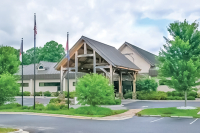Etowah Mound largest in the Southeast
 Etowah Indian Mounds State Historic Site.
Etowah Indian Mounds State Historic Site.
When I’m in the Atlanta area, I often set aside a few hours to visit the Etowah Indian Mounds State Historic Site, which is located on the western edge of Cartersville. For me, it’s the most impressive mound site in the southeastern United States. I recommend it to you.
The visitor center features one of the finest displays of Indian artifacts that I’ve seen. Most all of the items were excavated from a burial mound on the site by the Georgia Historical Commission in the late 1950s. Given the current attitude toward such excavations this would have rightly been taboo, but a half a century ago no one was hesitant to excavate such sites; so, one visits them with a bit of trepidation, hoping that what one learns and feels offsets the intrusion.
I have been encouraged in visiting and writing about such public sites to observe, in almost every instance, Native American visitors as well.
The copper metal work is the most extensive that I’ve encountered in the Southeast. And the marble statuettes of Kanati and Selu, the ancient male and female figures in Cherokee mythology, are excellent.
A self-guided trail will first take you by a defensive trench called a “borrow pit.” As dirt was dug to build the mounds, a trench 20 yards wide and 10 feet deep in places was created that surrounded the mounds and village on three sides. Just inside this trench the Indians built a palisade fence 15 or more feet high of sharp-pointed logs. At intervals along the palisade they placed lookout stands where bowmen could have a clear shot at enemies crossing the ditch and trying to breech the walls.
On the fourth side is the Etowah River, which also provided a barrier against invasion, as well as a place to bathe, launch canoes, fish, and practice their going to water ceremonies. During times of low water, one can still see the outlines of an ancient fish trap in the river. Located throughout the southern mountain region wherever the Cherokees and other tribes situated their large villages alongside major streams, these devices allowed for huge quantities of fish to be taken at one time.
Rock weirs or walls were constructed where the water was swift. Two converging, wall-like alignments formed a V-shape with an opening at its apex. Facing downstream, the V-shaped structure funneled fish into a wicker or log trap. Harvesting the fish swept into the traps was a piece of cake. They especially liked to catch freshwater catfish, which could be cleaned but not skinned and smoked over a fire. The smoked and dried catfish provided valuable protein during the winter months.
The guided trail also takes one through the area where a thriving town of 1,000-2,000 Indians lived between about 1000 and 1500 A.D. The central plaza in front of the largest mound, known as Mound A, served as sort of a village green.
It is a large area, maybe 30-by-40 yards, comprised of a clay surface that was carefully maintained. Here the Indians had a place to meet socially, welcome guests, or play games like stickball.
According to Jerry McDonald and Susan Woodward, who wrote Indian Mounds of the Atlantic Coast: A Guide of Sites from Main to Florida (Newark, Ohio: McDonald & Woodward Publishing Co., 1987), “the town centered upon the large temple mound (A) and two smaller platform mounds (B and C) … Mound A apparently supported structures used by the political and religious leaders.”
This structure was no doubt a seven-sided council house made from thatching tree limbs or river cane between posts and then covering the sides with clay in a process known as daub and wattle. The roof would have been thatched from cane or other materials. Inside were raised platforms where the clans and their leaders gathered.
A ramp on the eastern side of the mound (facing the rising sun) allowed access. Today there are wooden stairways where the old ramps were located so that visitors can also access the top of each mound without causing erosion on the sides.
Mound A is quite imposing, being about 60 feet high and 335-by-395 feet at its base. In a report on his mound explorations in the 1890s, the 19th century anthropologist Cyrus Thomas noted that “This is truly a grand and remarkable structure, being exceeded in size in the United States … only by the great Chokia mound,” which is located near St. Louis.
The use of Mound B is uncertain, but it may have been the site of a sub-chief’s residence, or maybe the location of a shaman who functioned as both a medicine man and as a priest.
The use of Mound C is certain. McDonald and Woodward describe it as being a “mortuary mound, site of the charnel house and numerous burials … Some burials were extended in-the-flesh burials, some of which were buried in stone tombs. Bundle burials and cremation were also represented. Grave goods associated with many of the burials of these burials were extremely rich and elaborate. Well represented were objects related to the Southern Ceremonial Complex and fine stone carvings, perhaps the most famous of which are two figures of humans carved in marble.
Until the state of Georgia obtained the site in the mid-20th century, it was first overgrown with trees and then cleared and farmed. The slopes of the lower mounds were cultivated as was the top of the Mound A.
Today the view from the top of Mound A is stunning. Where the council house once stood, there is a panoramic view of the Etowah River valley. Here, for 500 or more years, people farmed, went to war, fished, played games, sang and danced, raised their families, and died. And then they were driven away.
The site is closed on Monday. It is open year-round Tuesday through Saturday 9 a.m. to 5 p.m. and Sunday from 2 to 5 p.m. (except Christmas, Thanksgiving and New Year’s). There is a nominal admission fee. For information, call 404.387.3747. To reach the site from I-75, take Exit 24 (the Main Street exit) and follow the brown state signs for six miles through the town of Cartersville.
Editor’s note: This column first appeared in a December 2002 edition of The Smoky Mountain News.
(George Ellison is a writer and naturalist who lives in Bryson City. This email address is being protected from spambots. You need JavaScript enabled to view it.)





